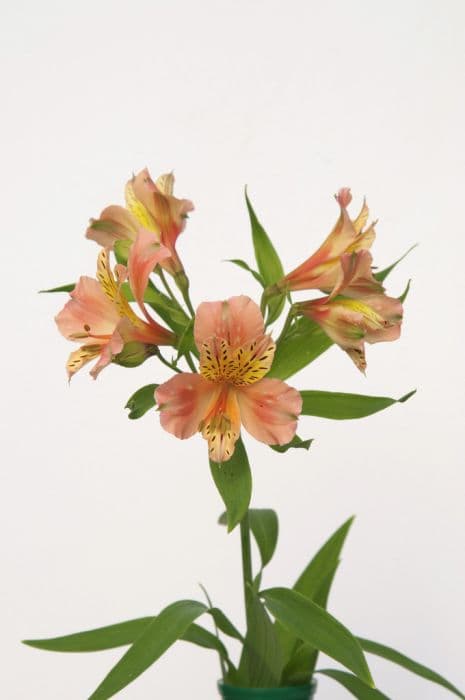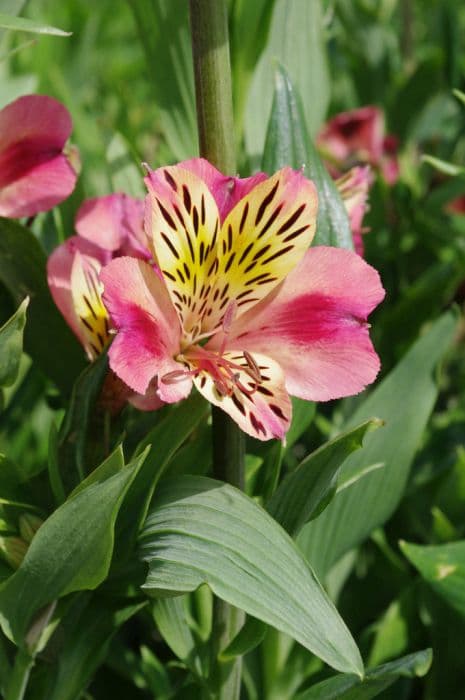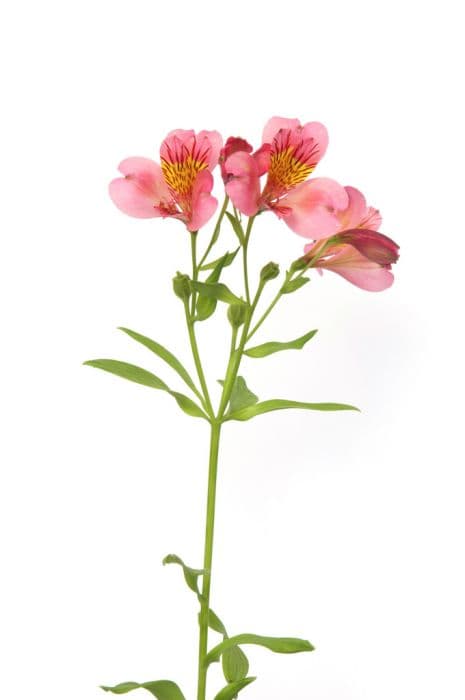Peruvian Lily Alstroemeria 'Natalie' (PBR) (Little Miss Series)

ABOUT
Alstroemeria 'Natalie', also known as the Peruvian Lily, is a striking plant part of the Little Miss Series. This plant features elegant, trumpet-shaped flowers with a beautiful blend of colors. The flowers of Alstroemeria 'Natalie' typically exhibit shades of pink, with dark pink speckles adorning the inner petal surfaces, creating an eye-catching contrast. These blooms are often characterized by their six petals, with the inner three slightly larger than the outer ones, each with a delicate, smooth edge that can occasionally display a slight ruffle. The Peruvian Lily's foliage adds to its visual appeal with lance-shaped leaves that are a rich green color. The leaves often grow in an upside-down fashion due to the stems twisting as they develop, a distinctive trait of the Alstroemeria genus. The overall appearance of Alstroemeria 'Natalie' is further enhanced by its branching habit, which gives the plant a lovely density and makes it an attractive addition to garden beds, borders, and floral arrangements.
About this plant
 Names
NamesFamily
Alstroemeriaceae
Synonyms
Peruvian Lily, Lily of the Incas, Parrot Lily
Common names
Alstroemeria 'Natalie' (PBR) (Little Miss Series)
 Toxicity
ToxicityTo humans
The Peruvian Lily, generally, is not considered highly toxic to humans. However, it can cause mild irritation if ingested due to the presence of tulipalin, which is a skin irritant. Some people might experience symptoms like nausea, vomiting, or diarrhea if any parts of the plant are consumed. Handling the plant might also cause skin irritation or dermatitis in sensitive individuals. It is advisable to wear gloves when handling this plant and to keep it out of reach of children who might accidentally ingest it.
To pets
The Peruvian Lily is known to be toxic to cats and dogs if ingested. The plant contains a compound called tulipalin, which can cause gastrointestinal irritation. Symptoms of poisoning may include vomiting, diarrhea, drooling, and lethargy. In some cases, there can also be an allergic dermatitis reaction if a pet comes into contact with the sap. It is important to keep this plant away from pets and seek veterinary attention if you suspect your pet has ingested any part of the plant.
 Characteristics
CharacteristicsLife cycle
Perennials
Foliage type
Deciduous
Color of leaves
Green
Flower color
Mixed
Height
1-2 feet (30-60 cm)
Spread
1-2 feet (30-60 cm)
Plant type
Bulb
Hardiness zones
7
Native area
South America
Benefits
 General Benefits
General Benefits- Attractive Blooms: The Alstroemeria 'Natalie' has vibrant, colorful flowers that are visually appealing and add a splash of color to any garden.
- Long Flowering Period: This perennial has a long blooming season, ensuring that gardeners can enjoy the flowers for an extended time each year.
- Low Maintenance: Alstroemeria 'Natalie' requires minimal upkeep once established, making it ideal for busy gardeners or those who prefer low-maintenance landscapes.
- Drought Tolerant: Once established, it has good tolerance to periods of drought, reducing the need for frequent watering.
- Attracts Pollinators: The flowers attract bees, butterflies, and other pollinating insects, which are beneficial for the garden ecosystem.
- Versatile Landscaping: Ideal for borders, containers, and as cut flowers due to its long stems and lasting blooms.
- Cold Hardy: It can tolerate colder temperatures, making it suitable for gardens in cooler climates.
 Medical Properties
Medical PropertiesThis plant is not used for medical purposes.
 Air-purifying Qualities
Air-purifying QualitiesThis plant is not specifically known for air purifying qualities.
 Other Uses
Other Uses- Edible Flowers: The blooms of the Alstroemeria can be used as a colorful, edible garnish for salads, desserts, and drinks.
- Natural Dyes: The pigments in Alstroemeria petals can be used for making natural dyes for fabrics or crafts.
- Photography Props: The striking appearance of the Alstroemeria 'Natalie' makes it a popular choice for floral photography and still-life compositions.
- Education: Alstroemeria can be used in educational settings to teach botany and horticulture, particularly regarding breeding techniques and plant genetics.
- Eco-Friendly Confetti: Dried petals of the Alstroemeria can be used as a biodegradable alternative to traditional paper confetti at celebrations.
- Craft Projects: The stems and flowers can be used in various craft projects including the creation of wreaths and natural potpourri.
- Ink Making: The pigments from Alstroemeria flowers may be used to create natural inks for art or calligraphy.
- Floral Ice Cubes: Frozen into ice cubes, the Alstroemeria petals can add an elegant touch to cold beverages and punches.
- Bookmarks: Pressed Alstroemeria flowers can be laminated to create unique and decorative bookmarks.
- Fragrance: Though not as common, Alstroemeria flowers can be included in potpourris or used to lightly scent linen and drawer sachets.
Interesting Facts
 Feng Shui
Feng ShuiThe Alstroemeria, commonly known as Peruvian lily or lily of the Incas, is not used in Feng Shui practice.
 Zodiac Sign Compitability
Zodiac Sign CompitabilityThe Peruvian lily is not used in astrology practice.
 Plant Symbolism
Plant Symbolism- Friendship - Alstroemeria, commonly known as Peruvian Lily or Lily of the Incas, often symbolizes strong bonds of friendship, due to its long-lasting nature.
- Wealth - The multiple colors and stripes on the petals represent a richness in spirit and material wealth.
- Devotion - Peruvian Lilies are presented as a symbol of devotion to loved ones, showing a deep commitment and dedication.
- Achievement - With its beautiful and various vibrant blooms, it can symbolize the achievement of personal aspirations and the joy of reaching one’s goals.
- Prosperity - The Peruvian Lily is sometimes given as a token for wishes of prosperity and growth, both in personal and professional realms.
 Water
WaterFor the Peruvian Lily, during the growing season, water regularly to keep the soil consistently moist but not waterlogged; once a week should suffice, providing about 1 to 1.5 gallons of water each time, depending on the weather conditions. In hotter, dryer periods, you may need to water twice a week. During winter dormancy, reduce watering frequency allowing the top inch of soil to dry out between waterings. Avoid overhead watering to prevent fungal diseases; instead, water at the base of the plant.
 Light
LightPeruvian Lilies thrive best in full sun to partial shade. They should receive at least 6 hours of sunlight daily, but in regions with very intense sun, some afternoon shade will help protect the flowers from scorching. A spot that receives morning sunlight and dappled shade in the afternoon is ideal for this plant.
 Temperature
TemperaturePeruvian Lilies can tolerate a broad range of temperatures but grow best between 65°F and 80°F. They can survive minimum temperatures of around 23°F but should be protected from frost. The ideal growing conditions include maintaining a temperature above freezing and avoiding extremes that could inhibit growth or flowering.
 Pruning
PruningPeruvian Lilies benefit from deadheading spent flowers to encourage continuous blooming throughout the summer. Cut the stems close to ground level to promote new growth; this can be done every few weeks during the blooming period. The best time for major pruning is in the fall after flowering has finished to help maintain the plant's shape and vigor.
 Cleaning
CleaningAs needed
 Soil
SoilAlstroemeria, commonly known as Peruvian Lily or Lily of the Incas, thrives best in fertile, well-draining soil with a pH range of 6.0 to 7.0. A good mix for this plant would be equal parts of peat, pine bark, and either perlite or coarse sand to ensure proper drainage and aeration. Adding a slow-release fertilizer to the mix can provide essential nutrients over time.
 Repotting
RepottingPeruvian Lilies should be repotted every two years to refresh the soil and accommodate their growing root system. It is best done in the spring or early summer, before the active growing season. Use a pot slightly larger than the previous one to allow space for growth.
 Humidity & Misting
Humidity & MistingPeruvian Lilies prefer moderate to high humidity levels for optimal growth. The ideal humidity range for these plants is between 40% to 60%. They can tolerate lower humidity levels, but providing a humid environment will promote healthier foliage and more vibrant blooms.
 Suitable locations
Suitable locationsIndoor
Place in bright, indirect light and water when the topsoil is dry.
Outdoor
Ensure full sun to partial shade and protect from strong winds.
Hardiness zone
7-10 USDA.
 Life cycle
Life cycleThe life cycle of the Alstroemeria 'Natalie', also known as Peruvian Lily or Lily of the Incas, begins with seed germination, which is generally facilitated by warm temperatures and moist soil conditions. Following germination, the seedling develops a root system and shoots appear above the soil, entering the vegetative growth phase where leaves and stems develop rapidly. The plant then reaches maturity and enters the flowering stage, where it produces its characteristically vibrant and speckled trumpet-shaped flowers that attract pollinators. After pollination, seeds are produced in fruit capsules, and as the flowering season ends, the plant may enter a dormancy period particularly in cooler climates, conserving energy for the next growing season. With the return of favorable conditions, the Peruvian Lily resumes growth, completing the cycle. The plant can also propagate vegetatively through the division of its rhizomes, creating clonal offshoots that develop into mature, flowering plants.
 Propogation
PropogationPropogation time
Spring-Early Summer
Propogation: The most popular method for propagating the Alstroemeria 'Natalie', commonly known as Peruvian Lily or Lily of the Incas, is through division. The best time to divide Peruvian Lilies is in early spring or late summer, after the blooming period, when the plant is not in active growth. To propagate by division, carefully dig up the clump of tubers, gently separating them while trying to keep as much of the root system intact as possible. Each division should have at least one growth bud. Replant the divisions at the same depth they were previously, spacing them about 12 inches (approximately 30 centimeters) apart to allow for growth. Water the newly planted divisions thoroughly to help establish their roots. This method is effective because the plant can recover quickly, and it ensures a clone of the parent plant, preserving its characteristics.




![Peruvian lily [Indian summer]](/_next/image?url=https%3A%2F%2Fplants-admin.emdemapps.com%2Fimages%2Fplants%2F%2Fimages%2F604b616bc746b.png&w=640&q=75)
![Peruvian lily [Inticancha Creamy Dark Pink]](/_next/image?url=https%3A%2F%2Fplants-admin.emdemapps.com%2Fimages%2Fplants%2F%2Fimages%2F604b5e98bea7c.png&w=640&q=75)
![Peruvian lily [Inticancha Imala]](/_next/image?url=https%3A%2F%2Fplants-admin.emdemapps.com%2Fimages%2Fplants%2F%2Fimages%2F604b619b522ba.png&w=640&q=75)
![Peruvian lily [Inticancha Red]](/_next/image?url=https%3A%2F%2Fplants-admin.emdemapps.com%2Fimages%2Fplants%2F%2Fimages%2F604b5aebac273.png&w=640&q=75)
![Peruvian lily [Inticancha Sunday]](/_next/image?url=https%3A%2F%2Fplants-admin.emdemapps.com%2Fimages%2Fplants%2F%2Fimages%2F604b646146dd9.png&w=640&q=75)
